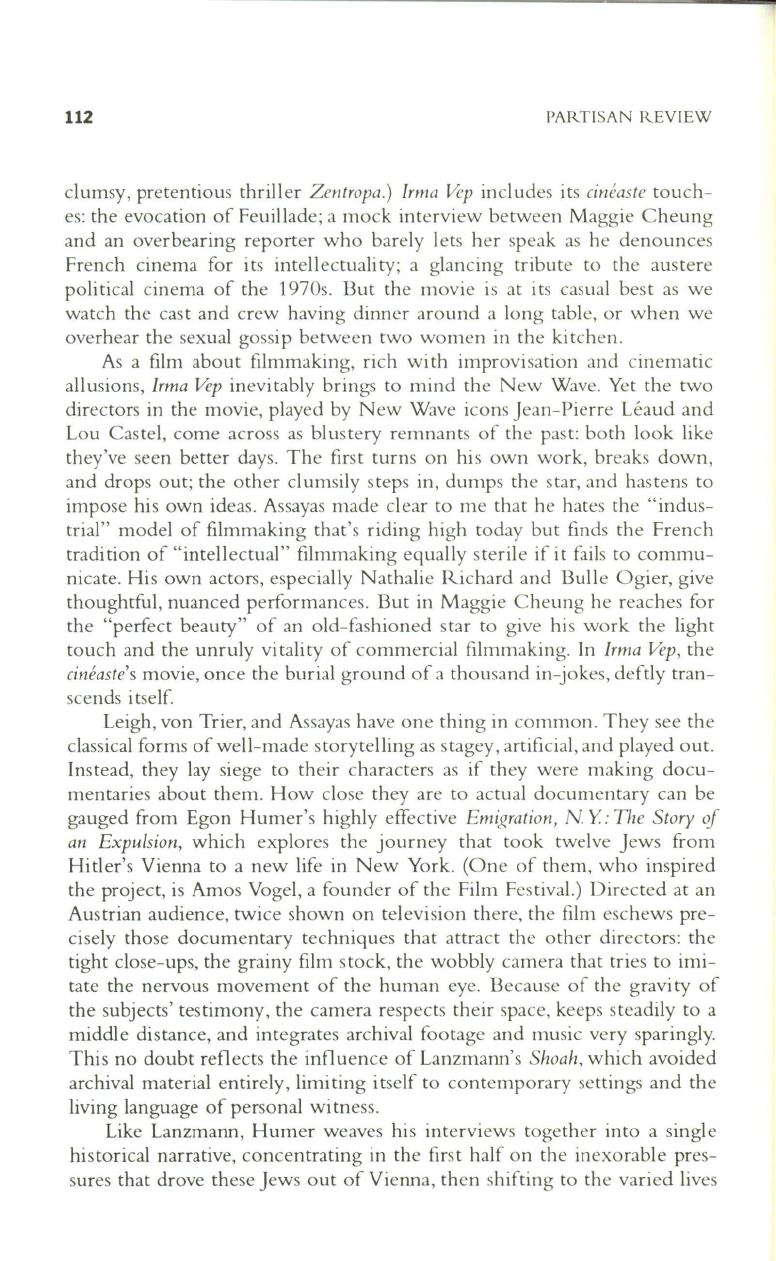
112
PARTISAN REVIEW
clumsy, pretentious thriller
Zentropa .) Irma Vep
incl udes its
cineaste
touch–
es: the evocation of Feuillade; a mock interview between Maggie Cheung
and an overbearing reporter who barely lets her speak as he denounces
French cinema for its intellectuality; a glancing tribute to the austere
political cinema of the 1970s. But the movie is at its casual best as we
watch the cast and crew having dinner around a long table, or when we
overhear the sexual gossip between two women in the kitchen.
As a film about filmmaking, rich with improvisation and cinematic
allusions,
Irma Vep
inevitably brings to mind the New Wave. Yet the two
directors in the movie, played by New Wave icons Jean-Pierre Leaud and
Lou Castel, come across as blustery remnants of the past: both look like
they've seen better days. The first turns on his own work, breaks down,
and drops out; the other clumsily steps in, dumps the star, and hastens to
impose his own ideas. Assayas made clear to me that he hates the "indus–
trial" model of filmmaking that's riding high today but finds the French
tradition of "intellectual" filmmaking equally sterile if it fails to commu–
nicate. His own actors, especially Nathalie Richard and Bulle Ogier, give
thoughtful, nuanced performances. But in Maggie Cheung he reaches for
the "perfect beauty" of an old- fashioned star to give his work the light
touch and the unruly vitality of commercial filmmaking.
In
Irma Vep,
the
cineaste's
movie, once the burial ground of a thousand in-jokes, deftly tran–
scends itself.
Leigh, von Trier, and Assayas have one thing in common. They see the
classical forms of well-made storytelling as stagey, artificial, and played out.
Instead, they lay siege to their characters as if they were making docu–
mentaries about them. How close they are to actual documentary can be
gauged from Egon Humer's highly effective
Emigration, NY: The Story oj
an Expulsion,
which explores the journey that took twelve Jews from
Hitler's Vienna to a new life in New York. (One of them, who inspired
the project, is Amos Vogel, a founder of the Film Festival.) Directed at an
Austrian audience, twice shown on television there, the film eschews pre–
cisely those documentary techniques that attract the other directors: the
tight close-ups, the grainy film stock, the wobbly camera that tries to imi–
tate the nervous movement of the human eye. Because of the gravity of
the subjects' testimony, the camera respects their space, keeps steadily to a
middle distance, and integrates archival footage and music very sparingly.
This no doubt reflects the influence of Lanzmann's
Shoah,
which avoided
archival material entirely, limi ting itself to contemporary settings and the
living language of personal wi tness.
Like Lanzmann, Humer weaves his interviews together into a single
historical narrative, concentrating in the first half on the inexorable pres–
sures that drove these Jews out of Vienna, then shifting to the varied lives


